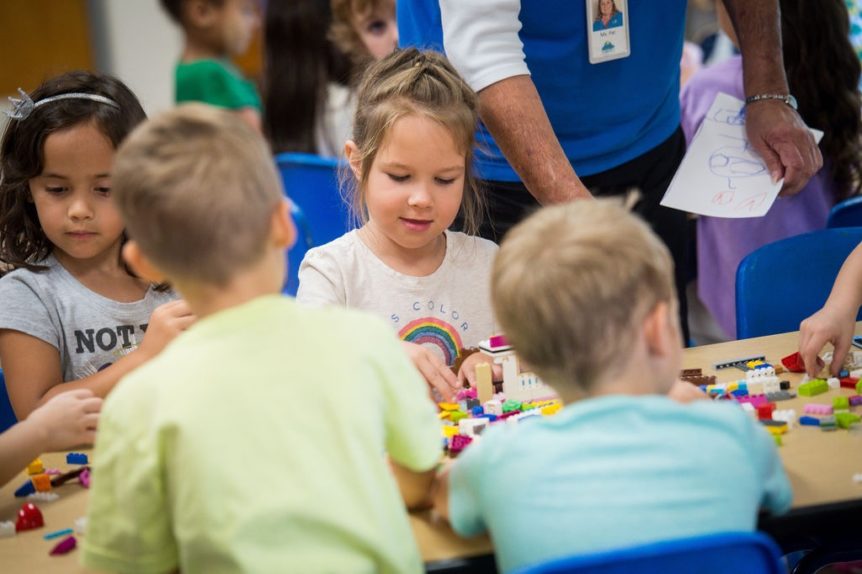Childcare centers meet the needs of children of a variety of ages, and must put a great deal of thought and effort into the spaces necessary for infants versus the spaces needed for a preschool classroom. You may find, as you visit daycare centers and as your own children grow from infancy into the preschool years, that their classrooms evolve, and their caregivers have very different approaches depending on the age of the children in their care. Top-notch daycare centers will think about the precise developmental needs of each stage and age, and will tailor their classrooms accordingly.
A quality infant room will be meticulously thought out and adheres to certain standards that keep babies safe and helps them to thrive in a daycare environment.
Features of a quality childcare infant room
Gross and fine motor development
Physical activities are learning opportunities for infants. A high quality daycare center will provide all of the opportunities and resources your baby needs to try new skills and master them. As your baby begins to sit, scoot, crawl, pull up, stand, and walk, your daycare provider should meet them where they are by providing her with safe surfaces to explore on and pull up on, and toys and activities that will incentivize her to move. And a great daycare center knows the value of providing toys that will help your baby develop her fine motor skills as well as her gross motor skills, allowing her to explore with her fingers and find new ways to manipulate toys and objects around her.
Social and emotional development
While infants do not engage in the same types of parallel and interactive play as older toddlers and preschoolers, they are ready to socialize, developing meaningful relationships and attachments to their caregivers and those around them. As your baby develops, he’ll need caregivers to respond to him as he babbles, clap when he achieves certain milestones, and teach him to share by not grabbing from others. Attentive caregivers and ratios that allow these interactions are incredibly important at this age.
Cognitive development
While infancy is not the time to push children to master cognitive skills they may not be ready for, it’s helpful to offer them toys which may stimulate learning as they grow older. A variety of toys presenting them with letters, numbers, shapes, and colors, providing them with early opportunities to recognize simple patterns and designs, will give them a boost as they head into their toddler years.
Language development
Babies take in a tremendous amount of language at a young age. Their understanding of words spoken to them and around them outpaces their ability to verbalize, so talking to them and responding to their non-verbal cues with verbal direction, reassurance, and guidance will help them to develop their language skills as they grow older.
A calming environment
Infant rooms at high quality daycares are usually orderly, uncluttered, and quiet, so that babies do not become overwhelmed. It is important for caregivers to make sure that the environment is attuned to the unique sensory needs of young babies.
A well-run preschool classroom often has very different physical space, caregiver interactions, and scheduling concerns from an infant room. Older kids have fewer physiological needs to attend to, but their cognitive and social-emotional development is often moving at a very quick pace, requiring a great deal of attention from staff.
Features of a quality preschool classroom
A defined educational philosophy
A childcare center which is truly intentional about its preschool program will have a well-defined educational philosophy and curriculum. Learning activities which are developmentally appropriate for children 3 or 4 years of age will set a positive tone that will encourage children to open their minds to the process of learning.
Communication between teachers and parents
It is important that parents play a role in their children’s early education, and preschool teachers in a high quality program will keep parents informed if a child is struggling, or if a child is excelling and might appreciate a challenge. Feedback is solicited from parents, and lines of communication are open and used consistently.
Teachers with experience and an appropriate educational background
In a preschool program, it’s important for teachers to have experience in child development, educational philosophies, and in running a classroom and engaging children in the process of learning. Teachers with a Child Development Associate credential are equipped to understand approaches that work for a variety of children with an array of learning styles. Staff should be trained in CPR and first aid, as well.
A focus on play in addition to work
The most promising early childhood education environments give children the opportunity to learn through play, whether they’re engaging in arts projects, science experiments, or learning about the natural world. Children at this age should be in a play-based environment where activities are tailored so that kids can learn, but feel engaged in play as well.
Attention to biological needs
This type of care does not end when children emerge from infancy. While the same constant attention to feeding and sleeping is not necessary for preschoolers, nutritious snacks and meals as well as adequate rest time are important. A high quality program will focus on nutrition, nourishing children with healthy, organic meals and snacks, with an emphasis on variety and novelty.
A developmentally appropriate approach to discipline
Preschool age kids are testing boundaries on a daily basis, and a disciplinary plan which acknowledges their emotions, respects their independence, but also helps to set firm limits around safety, respect for others, and age-appropriate behavior is key. If you are inquiring into preschool programs, asking them about their approach to discipline will tell you a great deal about how the staff takes challenges and turns them into opportunities for growth.
A quality childcare program understands the stark differences between infancy and preschool years, and will tailor their approach to a preschool classroom very differently from their infant room. As children move from one developmental stage to the next, their childcare program should reflect the changes they are going through, and a classroom’s design, resources, and philosophy will speak volumes about the center’s knowledge of child development.

